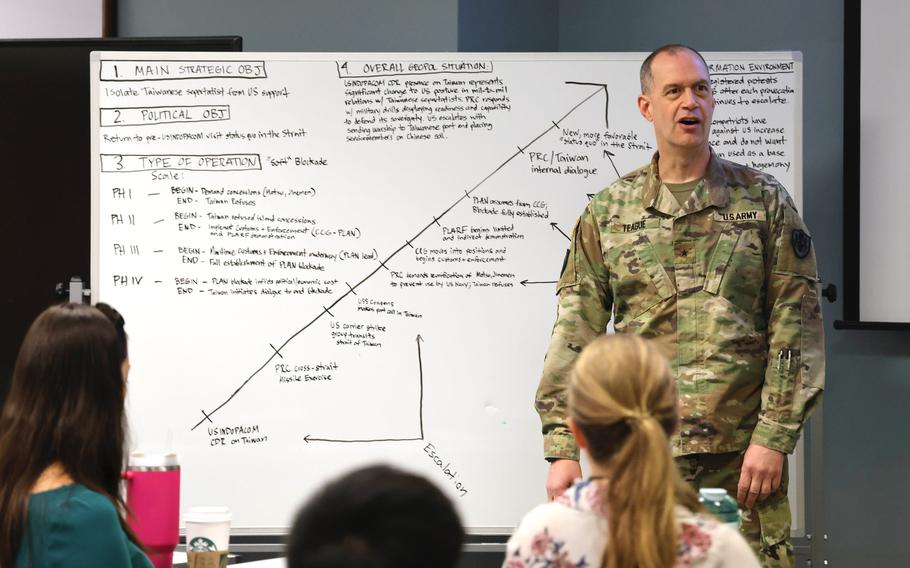
Army Brig. Gen. Patrick Teague, U.S. defense attaché to China, speaks during U.S. Army Pacific’s first class in the China Way of War at Schofield Barracks, Hawaii, on Feb. 9, 2024. (Taylor Gray/U.S. Army)
FORT SHAFTER, Hawaii — About 2,500 years ago, the Chinese philosopher and general Sun Tzu counseled military strategists that to know the enemy, become the enemy.
U.S. Army Pacific has taken to heart that ancient advice to develop a deep understanding of an adversary’s mindset with the launch of a course on the China Way of War.
The week-long course was piloted last fall, offered in Hawaii for the first time in February and will be pushed out across the Indo-Pacific region in coming months.
China and America are not enemies, of course, but they are deeply entwined in an economic, diplomatic and military competition. U.S. Secretary of Defense Lloyd Austin has described China’s military as America’s “pacing challenge.”
“We wanted people within this command to think about how China thinks,” Michael Schaefer, director of training at Army Pacific, said March 7 at Fort Shafter.
As compelling as the course may seem, China Way of War covers a much wider gamut than outright combat.
“It doesn’t just look at war,” Schaefer said. “Really, the idea would be, how do we prevent war? That’s really what we’re getting after — understanding that when we do something, there may be a response from China.”
China is expected to have a fully modernized military by 2035, according to the Office of the Director of National Intelligence’s annual threat assessment published in February.
“In the South China Sea, Beijing will continue to use its growing military and other maritime capabilities to try to intimidate rival claimants and to signal it has control over contested areas,” the assessment states. “Similarly, China is pressing Japan over contested areas in the East China Sea.”
Strategic thinking
The China Way of War, open to uniformed and civilian personnel of all services, exposes participants to Chinese strategic thinking, providing them an understanding of how the Chinese army, officially the People’s Liberation Army or PLA, might think about and act on varying scenarios.
It was modeled after a similar Army course in Europe that focused on Russia after its invasion of Ukraine two years ago, Schaefer said.
Army Pacific contracted Booz Allen Hamilton to design and facilitate its course, which is based entirely on open-source material and uses no classified information, Schaefer said.
As inscrutable as China’s military might seem, its chain of command employs an organized metric in making decisions, he said.
Commanders in the U.S. armed forces use a defined “military decision-making process” in responding to defense scenarios, he said.
“China has the same thing,” he said. “So, China has a deliberate decision-making process — completely unclassified. And it’s taught to [our] students so that each day they go through the decision-making process, and then they talk about what they think China may be thinking.”
On day one of the course, each student is assigned a role in the Chinese military.
“And then each day, the students are given scenarios, and they have to respond with how they think — they’re now the PLA — China is going to respond,” he said.
For example, perhaps a high-level dignitary flies into the Indo-Pacific region on a junket to Taiwan, a self-governing island over which China has claims of sovereignty.
“What do you think is going to be the response?” Schaefer said.
Students talk through the scenario, offering the likely response by the Chinese entity they are portraying.
It is a reverse perspective considered too rarely in the U.S. armed forces, he said.
Blue on Red
“In the military, we’re always the blue force; we’re always friendly guys taking on the red forces, no matter who it might be,” he said.
“As an intelligence officer, it’s incredibly important to know what the enemy thinks, so that you can try and predict what the enemy will do and why they make the decisions that they do,” Maj. Louis Crist, 10th Support Group, U.S. Army Japan, a February class member at Schofield Barracks, said in a Feb. 14 Army news release.
That session also included guest speaker Brig. Gen. Patrick Teague, a senior defense official and defense attaché to China.
Classes are limited to about 30 students, including students from allied and partner nations.
Schaefer said the Army intends to offer China Way of War eight to 10 times a year, including sessions taught by a mobile training team at Joint Base Lewis-McChord in Washington, and in Alaska, Japan and South Korea.